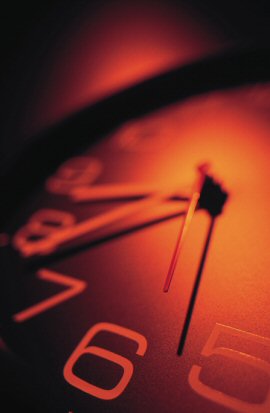10 January 2013
Telling time with matter waves
by Will Parker
 Berkeley scientists say they have discovered a way to tell time by measuring matter waves, the oscillations of matter whose frequency is 10 billion times higher than that of visible light. Intriguingly, team member Holger Müller says the technique can also be reversed to use time to measure mass.
Berkeley scientists say they have discovered a way to tell time by measuring matter waves, the oscillations of matter whose frequency is 10 billion times higher than that of visible light. Intriguingly, team member Holger Müller says the technique can also be reversed to use time to measure mass.
The technique takes advantage of the fact that matter can be both a particle and a wave. In a paper in Science, Müller and his colleagues describe how to tell time using only the matter wave of a cesium atom. He refers to his method as a Compton clock because it is based on the so-called Compton frequency of a matter wave.
The idea that matter can be viewed as a wave was the subject of a 1924 thesis by Louis de Broglie, who took Albert Einstein's idea that mass and energy are equivalent (E=mc2) and combined it with Ernst Planck's idea that every energy is associated with a frequency. De Broglie's idea that matter can act as a wave was honored with the Nobel Prize in Physics in 1929.
Using matter as a clock, however, has always appeared far-fetched because the frequency of the wave (the Compton, or de Broglie, frequency) might be unobservable. And even if it could be seen, the oscillations would be too fast to measure.
Müller, however, found a way two years ago to use matter waves to confirm Einstein's gravitational redshift - that is, that time slows down in a gravitational field. To do this, he built an atom interferometer that treats atoms as waves and measures their interference.
"At that time, I thought that this very, very specialized application of matter waves as clocks was it," Müller said. "When you make a grandfather clock, there is a pendulum and a clockwork [mechanism] that counts the pendulum oscillations. So you need something that swings and a clockwork to make a clock. There was no way to make a clockwork for matter waves, because their oscillation frequency is 10 billion times higher than even the oscillations of visible light."
Last year, however, he realized that he might be able to combine two well-known techniques to create such a mechanism and explicitly demonstrate that the Compton frequency of a single particle is, in fact, useful as a timing reference. The hybrid method relies on how, in relativity, time slows down for moving objects, so that a twin who flies off to a distant star and returns will be younger than the twin who stayed behind - known as the twin paradox.
Similarly, a cesium atom that moves away and then returns is younger than one that stands still. As a result, the moving cesium matter wave will have oscillated fewer times. Accordingly, the difference frequency, which would be around 100,000 fewer oscillations per second out of 10 million billion billion oscillations (3 x 1025 for a cesium atom), might be measurable.
In the lab, Müller showed that he could measure this difference by allowing the matter waves of the fixed and moving cesium atoms to interfere in an atom interferometer. The motion was caused by bouncing photons from a laser off the cesium atoms. Using an optical frequency comb, he synchronized the laser beam in the interferometer with the difference frequency between the matter waves so that all frequencies were referenced solely to the matter wave itself.
Müller's clock is accurate to within 7 parts per billion, a long way short of today's atomic clocks, but he says improvements in the technique could boost its precision. "That's like measuring one second out of eight years, about as good as the very first cesium atomic clock about 60 years ago," he said. "Maybe we can develop it further and one day define the second as so many oscillations of the Compton frequency for a certain particle."
Müller believes the technique can also be turned around to use time to measure mass. The reference mass today is a platinum-iridium cylinder defined as weighing one kilogram and kept under lock and key in a vault in France, with precise copies sparingly dispersed around the world. Using the matter wave technique might provide a new way for researchers to build their own kilogram reference. "Knowing the ticking rate of our clock is equivalent to knowing the mass of the particle, and once the mass of one atom is known, the masses of others can be related to it," he explained.
Related:
Discuss this article in our forum
New boson could be Higgs particle, say CERN boffins
New experimental findings challenge theory of electromagnetism
Experiment could reveal mechanism behind quantum entanglement
Are we living in a computer simulation? Physicists propose test to find out
Source: University of California - Berkeley
